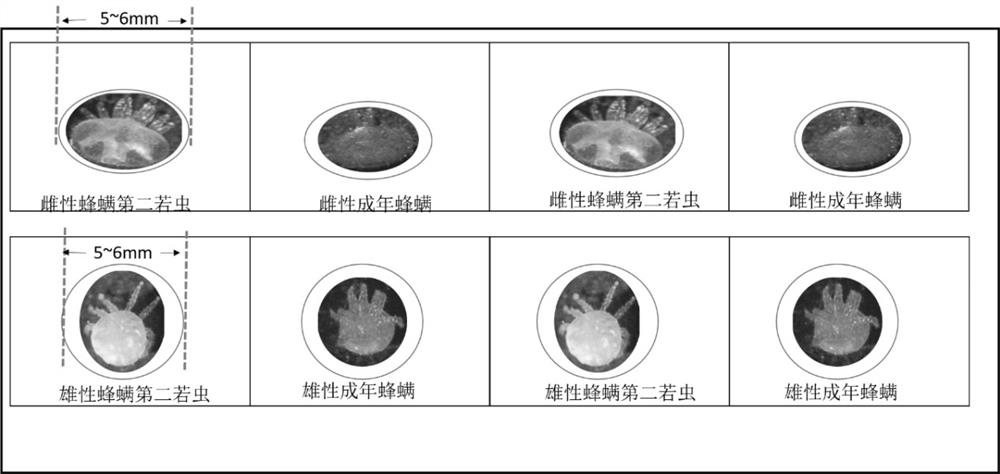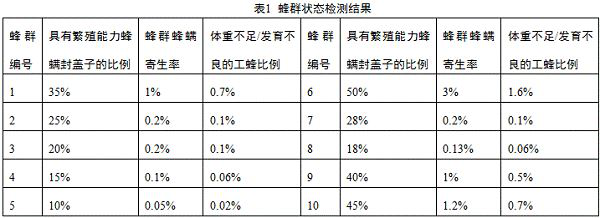Method and device for breeding anti-bee-mite bee species and application of method and device
A technology for bee mites and bee species, applied in the field of bee breeding, can solve the problem of not fundamentally removing bee mites, and achieve the effects of improving the anti-mite ability of bee colonies, low cost, and simple detection method.
- Summary
- Abstract
- Description
- Claims
- Application Information
AI Technical Summary
Problems solved by technology
Method used
Image
Examples
Embodiment 1
[0036] This embodiment provides a device for identifying male and female bee mites, said device at least comprising a female bee mite identification groove and a male bee mite identification groove;
[0037] The cross-sectional shape of the female wasp mite identification groove is oval, the major axis is between 5 ~ 6mm, and the short axis is between 2 ~ 4mm;
[0038] The cross-sectional shape of the drone mite identification groove is circular, and the diameter is between 5 and 6 mm.
[0039] Further, the female bee mite identification groove is a pit in the shape of a female bee mite adult or the second nymph of a female bee mite, with a depth of 8 mm to 10 mm; the male bee mite identification groove is in the shape of a male bee mite adult or a male Dimples in the shape of the second nymph of the bee mite, with a depth of 8mm~10mm.
[0040] Further, there is a photo of the adult female bee mite on the surface of the pit in the shape of an adult female bee mite; there is a...
Embodiment 2
[0046] Based on a device for identifying male and female bee mites provided in Example 1, this embodiment further provides a method for identifying the anti-mite ability of bee colonies, the process is as follows:
[0047] 1. Number the bee colonies that need to be identified, which can be numbers or letters. In this embodiment, the numbers are in the form of 1, 2, 3....
[0048] 2. Take out a piece of spleen covered with a cover from each bee colony, and mark it.
[0049] 3, check for the sub-spleen, after opening the cover, record whether bee mite is found in the cover, if find bee mite offspring, then identify the bee mite in the cover by the device shown in Example 1, specifically The following situations will occur:
[0050] (1) No bee mite found: no bee mite infection;
[0051] (2) Bee mites are found in bee pupae less than 7 days old: bee mites are infected, and bee mites may complete the reproductive process;
[0052] (3) The offspring of the bee mite are found in t...
Embodiment 3
[0059] In this embodiment, 10 different bee colonies are identified by the method described in Example 2, and they are numbered 1 to 10 in turn; 5 sealed sub-spleens are taken in each bee colony for identification (these sub-spleen seals The number of covers is between 4000 and 5000), and the average value is taken for the proportion of caps with reproductive ability bee mites. The present invention detects the bee colony mite parasitic rate of No. 1 to No. 10 bee colonies (detected by the existing soapy water method, brief steps: 1. Take 1 liter of water, add a tablespoon of laundry detergent that is not easy to foam 2. Put 200 bees into the bottle, close the lid, and shake the bottle on a shaker for 30 minutes. 3. Take out the bees in the bottle, count the number of bee mites in the soapy water, and calculate the number of bee mites per 100 bees Do 5 repetitions for each colony of bees, and calculate the average, which is the bee mite parasitism rate.), the following results...
PUM
 Login to View More
Login to View More Abstract
Description
Claims
Application Information
 Login to View More
Login to View More - R&D
- Intellectual Property
- Life Sciences
- Materials
- Tech Scout
- Unparalleled Data Quality
- Higher Quality Content
- 60% Fewer Hallucinations
Browse by: Latest US Patents, China's latest patents, Technical Efficacy Thesaurus, Application Domain, Technology Topic, Popular Technical Reports.
© 2025 PatSnap. All rights reserved.Legal|Privacy policy|Modern Slavery Act Transparency Statement|Sitemap|About US| Contact US: help@patsnap.com


